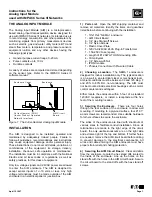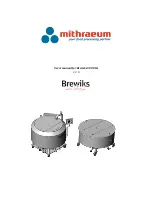
Instructions for the
Analog Input Module
used with IMPACC Series III Networks
April 15, 1997
Page 1
THE ANALOG INPUT MODULE
The Analog Input Module (AIM) is a microprocessor-
based analog input data acquisition device designed for
use with IMPACC Series III networks. Its intended use is
to record energy consumption and other parameters by
monitoring signals from primary measurement devices
such as electric, gas and water utility meters, BTU and
steam flow meters, temperature and pressure sensors,
equipment runtime and any other devices having the
following signal types:
•
General purpose current loops, 0-20 mA
•
Pulse contacts up to 10 Hz
•
Runtime contacts
A variety of values are computed and stored depending
on the sensor type. Refer to the IMPACC Series III
software manual.
A I M C i r c u i t
B o a r d
C u t l e r - H a m m e r I P O N I
( I n c o m P r o d u c t O p e r a t e d
N e t w o r k I n t e r f a c e )
E n c l o s u r e
E n c l o s u r e C o v e r
Figure 1 The Cutler-Hammer Analog Input Module
INSTALLATION
The AIM is designed to be installed, operated and
maintained by adequately trained people. Failure to
follow all guidelines, recommendations and instructions
may cause equipment damage and/or personal injury.
These instructions do not cover all details, variations, or
combinations of the equipment, its storage, delivery,
installation, check-out, safe operation or maintenance.
The installation must be in compliance with the National
Electric and all local codes or regulations, as well as
safety practices, for this class of equipment.
Only low voltage signals and 24VAC power are allowed
to enter the AIM enclosure. The AIM is designed to
accept sensor inputs of +/-10 volts or less. Any high
voltage terminations must be made outside of the AIM
enclosure in an electrical panel or junction box.
1) Parts List. Open the AIM shipping container and
remove all materials. Identify the items and quantities
listed below before continuing with the installation
1 - 10”x10”x4” NEMA 1 enclosure
1 - AIM Circuit Board
6 - 1/4” Hex Stand-off Screws
6 - 1/4” Nylon Screws
1 - Plastic Cover Plate
1 - 120 VAC/24VAC 24VA Plug-In Transformer
1 - 1.5A 250V Fuse (spare)
2 - Length of #12 AWG THHN Grounding Wire
4 - Crimp Eyelet
2 - 1/4” Screw with Nut
1 - IPONI module
1 - Phoenix Connector with Pre-wired Cable
2) Choosing a Location. The NEMA 1 enclosure is
designed for indoor installation only. The typical location
is on a wall in an electrical closet or mechanical room.
Ambient conditions must be between 32 and 125 Deg. F
and 20% to 80% RH, non-condensing. The AIM must
not be mounted inside electrical housings such as motor
control centers and switchgear.
Either locate the enclosure within 5 feet of a standard
120VAC receptacle, or install a receptacle within five
feet of the mounting location.
3) Securing the Enclosure. There are four holes
through the rear surface of the enclosure to allow wall
mounting. If mounting to a plywood surface, four #10 1”
wood screws are recommended. Use suitable hardware
for other surfaces to secure the enclosure.
The sides of the enclosure are lined with knockouts of
various sizes to facilitate conduit installation. Since all
terminations are made to the right edge of the circuit
board, the only usable knockouts are on the right side
and extreme right of the top and bottom. If further holes
are needed, remove the AIM circuit board before drilling
to prevent damage to the electrical components. All
wires and cable entering the AIM enclosure must have
proper strain relief and chafing protection.
4) Securing the AIM Circuit Board. Clear all debris
from the enclosure. Locate the hex stand offs riveted to
the inside of the enclosure. Line up the holes on the
stand offs with the holes in the AIM circuit board. Secure
the circuit board to the stand offs with the hex stand off
screws.






















